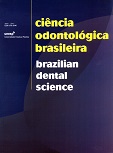Shear bond strength of resin composite to enamel treated with Er:Y AG laser and phosphoric acid
DOI:
https://doi.org/10.14295/bds.2007.v10i4.266Abstract
The purpose of this work was to evaluate the shear bond strength of resin composite to enamel treated with Er:YAG laser. It was used 33 human third molars. After the dental crowns cutting, the mesial and distal surfaces were embedded perpendicularly to the PVC cylinders long axis. Enamel was ground and the samples were randomly divided into 6 groups: G1- phosphoric acid (control), G2- Er:YAG laser (60mJ/10Hz), G3- Er:YAG (100mJ/10Hz), G4- Er:YAG (60mJ/10Hz + acid), G5- Er:YAG (100mJ/ 10Hz + acid), G6- Er:YAG (80mJ/2Hz). In all groups, Single Bond was used and resin composite cylinders (Z100) were prepared. The samples were stored in distilled water at 37oC for 24 hours and submitted to shearing test. G1 presented bond strength values significantly higher than G2, G3 and G6. The groups irradiated only with Er:YAG laser, in different intensities and frequencies, were equivalent as for the bond strength values. The groups treated with laser + acid presented strength values statistically equal to those of the control group. The enamel treatment with phosphoric acid, or its association with laser, is important to obtain good bond. The use of Er: YAG laser alone is not recommended, considering the conditions tested in this study.Downloads
Downloads
Published
How to Cite
Issue
Section
License
Brazilian Dental Science uses the Creative Commons (CC-BY 4.0) license, thus preserving the integrity of articles in an open access environment. The journal allows the author to retain publishing rights without restrictions.
=================




























